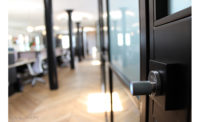New Locks Add Security & Convenience at Logix Credit Union

Convenience and security haven’t always been mutually beneficial, particularly for financial institutions and credit unions. Sometimes the necessary and important steps to ensure security stifle efficiency and add cost.
The Logix Federal Credit Union in California was founded as the Lockheed Aircraft Employees Federal Credit Union in 1937. It has maintained a perfect record of positive earnings since 1937, is rated A+ by DepositAccounts and ranks 38th on their America’s Top 200 Healthiest Credit Unions Report. Logix also holds a 5-Star rating for financial strength from Bauer Financial. And, it has made the Forbes “Best in State” list for credit unions for two consecutive years.
“High performance is in our DNA,” said Hamid Abbassi, safety and security at Logix. “We’re always on the lookout for new ways to achieve even higher standards, including operational improvements that allow us to focus more of our efforts on serving our customers. When we really studied it, access control emerged as an important opportunity.”
Most branches have multiple ATMs, a cash safe and a night depository. Branch employees have access to all or some of these based on a unique PIN. Code management was handled in the traditional way by sealing them in an envelope and sending to the credit union’s headquarters. If an employee needed to float between branches, he or she would need codes for multiple branches. When an employee left, the lock had to be manually reprogrammed by a locksmith to remove the employee’s code. The cost of code management increased while the level of security decreased because codes were inactive in a lock that no longer had an employee assigned to it.
“Our code management process was labor intensive and made it difficult to stay current,” Abbassi said. “In addition, we could only assign nine users per lock. In branches with up to 25 users, this created a burden. Branch managers had to keep close track of who had access to what lock and make sure that employee schedules matched the needs of those locks.”
Logix outlined several opportunities to improve efficiency and reduce cost: reduce service and locksmith charges; remove lock user management from the individual branch managers; allow more users per lock in each location; and central lock management with the Logix Security Team.
“We used or tested several access control solutions before turning to dormakaba,” Abbassi said. “The Axessor IP Locks allowed us to accomplish our goals and go one step further. Not only have we reduced our costs, we’ve completely wiped out service and locksmith charges. Every branch now has the ability to include or exclude every user in every lock without worrying about capacity. There’s no more sharing combinations.”
The dormakaba Axessor IP lock series, new to North America but available in Europe for 15 years, integrates the latest technical advances and meets all recognized safety standards. The modular electronic safe lock can be networked or used as a single standalone unit. Axessor locks maintain up to 40 user codes and can be efficiently managed remotely. With the remote access function, administrators can discretely check the lock status and perform up to 10,000 audit events. The software is not connected to any database. It is a standalone unit for unique 8-digit combinations. The Axessor solution is powered by house power with a battery backup. Its only requirement is attachment to a network cable running into the safe.
Compared to the USB version, the IP enabled Axessor lock offers an extended scope of features and an optional extension, the eBox for connecting to a TCP/IP network for central control of all locks. The networking allows easy and resource-optimized management and monitoring of an unlimited number of locks. All network communication with a remote SDK or AS284 software is encrypted by the widely used AES standards. With the eBox additional five input and output ports are available.
Abbassi said that Axessor’s remote audit capability, a must-have in the financial industry, was another important selling point.
“The lock audit allows us to view history on every lock at every location from our desks, allowing us to verify users, track audits without error and troubleshoot potential problems,” Abbassi said. “The locks reprogram so easily, that once installed, there is virtually no need for service.”
Installation of the Axessor required a unique partnership between Logix and dormakaba to ensure that the transition from the old system would not disrupt daily branch operations. The process included carefully timed stages to allow for in-house beta testing, software training and collaboration with Logix’s security integrator. The roll out was seamless. In addition, Logix was able to remove a lot of administrative burden from individual branch managers and increase efficiency at every location.
“We’ve received numerous compliments on the Axessor locks and not a single complaint — which is difficult in today’s world,” Abbassi said. “And, speaking of today’s world, I can’t imagine what our COVID-19 response would have looked like with these locks. They made it simple and easy for us to move users between locations, reprogram forgotten combinations and manage users everywhere. None of this would have been possible in the current pandemic if we had not had Axessor locks already installed. This product is so far ahead of our traditional practices.”
Looking for a reprint of this article?
From high-res PDFs to custom plaques, order your copy today!





